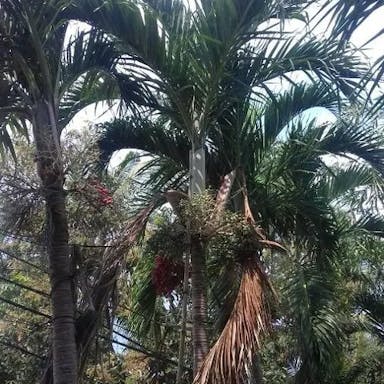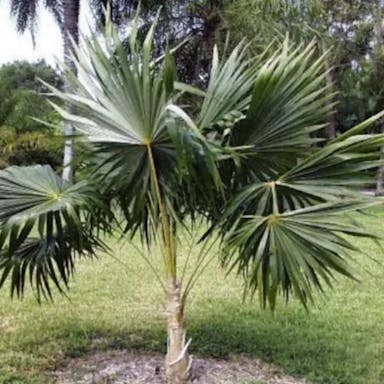Peach palm, scientifically known as Bactris gasipaes, is a tropical plant native to South and Central America. It is a spiny palm with pinnate leaves that can reach up to 20 meters in height. The flowers of the Peach palm are small, yellow to orange in color, and are arranged in clusters. The fruit of the Peach palm is edible and is commonly used in traditional dishes in the regions where it grows. The fruit is typically orange or red when ripe and contains a single large seed. There are several varieties of Bactris gasipaes, each with slightly different characteristics. Peach palm is relatively easy to grow in tropical climates and is often cultivated for its fruit. It is a popular plant in agroforestry systems due to its versatility and the nutritional value of its fruit.
Peach palm
- Scientific name
- Bactris gasipaes
Basic Information
- Arecaceae Family Bactris Genus Peach palm Species
- Arecaceae > Bactris > Bactris gasipaes
- 83%
- The Completeness of This Encyclopedia
Please help us complete the encyclopedia, Terrarium is a encyclopedia service to be completed with everyone in the world. Currently, this page is 83% complete. For more information on how to contribute, please click here.
- Palmae
- Tree
- Height
- 20000cm ~
- Flower Color
- Leaf Color
- Anthesis
- Sunlight Exposure
Full Sun Long hours of sunlight from morning to afternoon Partial Shade A location in the shade of a tree or where either the morning or afternoon is shaded Full Shade A place where there is no direct sunlight
- Full Sun
- Hardiness Zones
This is an indicator to know to which zone each plant can winter. Knowing the zone of each plant gives you an idea of the cold temperature resistance when grown in the ground without a roof. 2: -42.7 to -40.0 3: -39.9 to -34.4 4: -34.3 to -28.9 5: -28.8 to -23.3 6: -23.2 to -17.8 7: -17.7 to -12.2 8: -12.1 to -6.7 9: -6.6 to -1.1 10: -1.0 to 4.4 11: 4.5 to 10.0
- 13
- Cold resistance
- Poor
- Heat resistance
- Excellent
- Habitat of origin
- Central America, South America
- Growth Rate
- Fast
What is Peach palm (Bactris gasipaes)?
What is Peach palm (Bactris gasipaes)
Flower meaning
The flower language commonly used in America for the Peach palm is: - Gratitude - Appreciation - Friendship One typical example is: - Gratitude: Peach palm flowers symbolize gratitude, expressing thankfulness and appreciation towards others. Birth flowers: -
Calendar of Peach palm (Bactris gasipaes)
Calendar
Peach palm in the United States typically blooms during the spring and summer months. The flowers are at their best in late spring to early summer. Blooming usually occurs once a year, lasting for several weeks. It takes about 2-3 weeks for the flowers to fully bloom. To make the flowers last longer, ensure the plant receives adequate sunlight, water, and nutrients. Pruning dead or damaged branches can also promote more blooms.
How to grow Peach palm (Bactris gasipaes)
Watering
For optimal growth, water Peach palm plants every 2-3 days during the growing season. Ensure the soil is consistently moist but not waterlogged. During the dormant season, reduce watering frequency to once every 7-10 days. Monitor soil humidity levels by inserting a finger into the soil up to 2 inches deep; if it feels dry, it's time to water. Adjust watering amounts based on the plant's size and environmental conditions. Avoid letting the soil completely dry out between waterings to prevent stress on the plant. Maintaining proper watering practices is crucial for the health and vitality of Peach palm plants.
Soil and Fertilizer
Peach palm thrives in well-drained, fertile soils with a pH range of 5.5 to 6.5. It requires regular fertilization to support its growth and fruit production. Fertilizers rich in nitrogen, phosphorus, and potassium are beneficial for peach palm. Application of a balanced fertilizer with a ratio of 10-10-10 or 20-20-20 is recommended. Fertilizer should be applied three times a year, during the beginning of the rainy season, mid-rainy season, and at the end of the rainy season. The amount of fertilizer applied depends on the age and size of the plant. Regular soil testing is essential to monitor the nutrient levels and adjust the fertilizer application accordingly.
Sunlight and Place
Peach palm thrives in full sun to partial shade, preferring at least 6 hours of direct sunlight daily. It can tolerate a wide range of temperatures, from 20°F to 100°F, but its optimal growth occurs between 70°F to 90°F. During winter, protect it from frost by covering or moving it indoors. In hot climates, provide some afternoon shade to prevent leaf scorch. Peach palm is resilient to heat but may benefit from extra protection during extreme heatwaves. It is essential to acclimate the plant gradually to direct sunlight to avoid sunburn. Aim for consistent sunlight exposure to promote healthy growth and fruit production.
Advanced Information of Peach palm (Bactris gasipaes)
Pruning
Peach palm benefits from regular pruning to remove dead or damaged fronds, promote new growth, and maintain a tidy appearance. Pruning is typically done in late winter or early spring before the growing season begins. To prune, use sharp, clean tools to cut fronds at the base where they meet the trunk. Avoid cutting too close to the trunk to prevent damage. After pruning, remove any debris from around the plant to prevent pests and diseases. Regular pruning helps Peach palm thrive and stay healthy, ensuring optimal growth and fruit production.
Planting and Harvest
Peach palm is best suited for potted planting due to its ability to thrive in containers. To pot a Peach palm, choose a container with good drainage, fill it with well-draining soil, and plant the seedling at the same depth as it was in its nursery container. Water the plant thoroughly after planting and place it in a location with bright, indirect sunlight. Repotting should be done every 2-3 years or when the roots outgrow the container. When mishowing, ensure the plant receives enough water and sunlight, and protect it from extreme temperatures.
Propagation
Peach palm can be propagated through seeds, division, and stem cuttings. Seeds should be sown in well-draining soil, kept moist, and germinated in a warm, humid environment. Division involves separating the plant into smaller sections with roots attached, ensuring each section has enough roots to support growth. Stem cuttings should be taken from healthy, mature plants, treated with rooting hormone, and planted in a suitable growing medium. Using multiple propagation methods increases the chances of successful propagation and allows for the production of a larger number of plants. Harvesting fruits for seeds should be done when they are fully ripe to ensure viable seeds for propagation.
Pests and Diseases
Peach palm is susceptible to various pests and diseases, including red palm mite, bud rot, and peach palm caterpillar. These pests can cause significant damage to the plant, leading to reduced yield and overall health. Red palm mites are tiny pests that feed on the plant's leaves, causing them to turn yellow and eventually die. Bud rot is a fungal disease that affects the plant's growing tips, leading to wilting and decay. Peach palm caterpillars feed on the plant's leaves, causing defoliation and stunted growth. To prevent these issues, regular monitoring of the plant for any signs of pests or diseases is crucial. Implementing proper cultural practices such as adequate watering, fertilization, and pruning can help improve the plant's resistance to these problems. Additionally, using appropriate pesticides or fungicides when necessary can help control pest and disease infestations.
Habitat of Peach palm (Bactris gasipaes)
Habitat
Toxicity of Peach palm (Bactris gasipaes)
Health Benefits
- edible
- edible
- Toxic
- No toxicity
NO DATA
Toxic for dogs and cats
NO DATA











